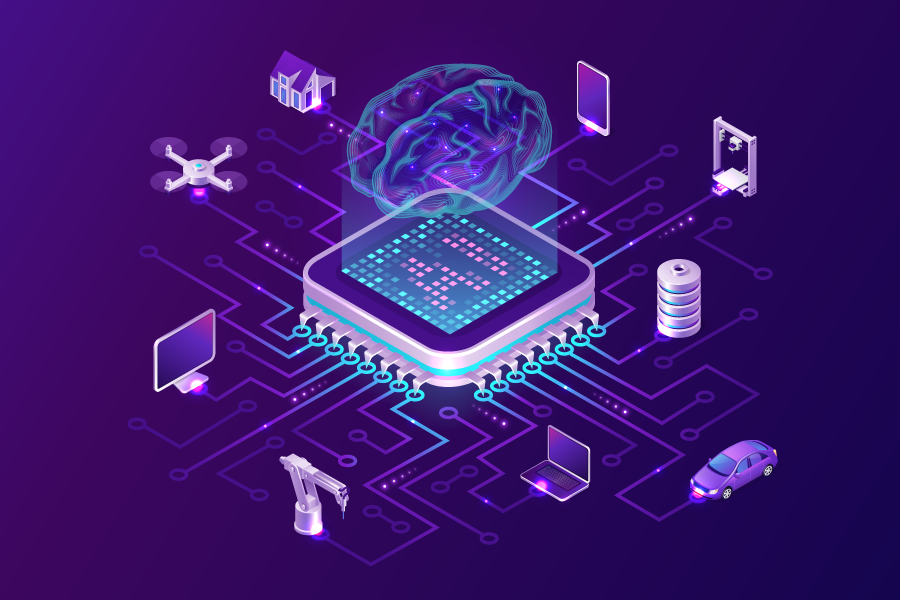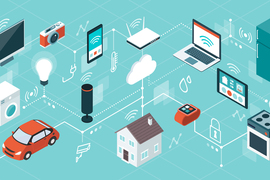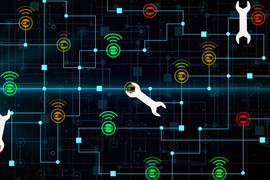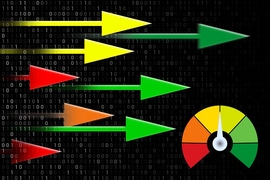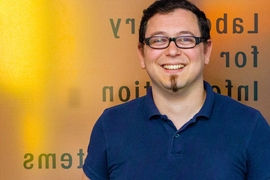The following article was adapted from a joint release by the MIT Materials Research Laboratory and Ericsson Research.
As we enter a new age for electronics powered by 5G and eventually 6G networks, the MIT Materials Research Laboratory and Ericsson are collaborating on two research projects that seek to help build a new network infrastructure needed to empower the truly revolutionary use cases the next generation of mobile networks will bring.
New mobile network generations bring ultra-fast speed, low latency, and superb reliability to the end user. However large, feature-rich networks are complex structures to manage for network operators. Ericsson is working to research cognitive networks, which rely on artificial intelligence (AI) to enable a secure, highly automized, data-driven network operation.
The two new research projects will address the compute power, speed, and energy efficiency of cognitive networks. The first is focused on fundamental studies to discover new materials for computer chips that mimic the structure of the human brain in order to use exponentially less energy than today’s silicon-based chip designs. This project will also include research on the devices that use those materials and the computer architectures the resulting systems will run on. The second project in the collaboration will explore ways to make some future electronic systems truly autonomous by removing the need for charging. The researchers aim to power devices through the air using the radio frequency waves conventionally used for TV and communication signals.
“As energy-efficient connected devices take the next leap forward, we are thrilled to be collaborating with Ericsson to tackle the key technical challenges,” says MIT Professor Anantha P. Chandrakasan, dean of MIT’s School of Engineering. “By combining our knowledge with Ericsson’s expertise in mobile technology, we aim to develop hardware that will power exciting new AI applications on the edge, and take significant strides in the next generation of mobile networks.”
“5G is leading to a fully-realized IoT and bringing us closer to a truly connected world,” says Magnus Frodigh, head of Ericsson Research. “Massive amounts of tiny IoT devices and AI-driven, cognitive networks are two drivers of the next leap forward. Working with the brilliant teams at MIT, we hope to develop the hardware that will make that possible.”
Enter Lithionics
Lithium has made a name for itself as a key element in state-of-the-art batteries for products such as electric cars. More recently, however, researchers including MIT professors Jennifer Rupp and Martin Bazant have shown that some battery electrodes made with lithium are also ideal for other applications, including computing. For example, lithium oxide materials could be key components of memristors, the successors of the transistors synonymous with computing today. Memristors require much less power than transistors because they can combine the functions of data storage (memory) and data processing in one unit, rather than shuttling the data between different units. Also, they are capable of executing so-called neuromorphic computing, which involves chips that mimic the structure of the human brain.
Enter lithionics, a term coined by Rupp and her students for the new field they created. “The vision of lithionics is, what other functional devices can we create with lithium that go beyond batteries to store, transfer and compute information?” says Rupp, who holds appointments in MIT’s Department of Materials Science and Engineering and Department of Electrical Engineering and Computer Science. Rupp is also affiliated with MIT’s Materials Research Laboratory.
Rupp and Saeed Bastani of Ericsson are principal investigators for an interdisciplinary team of four research groups working to apply lithium to next-generation neuromorphic computing systems. “We’re looking at everything from the core materials science to the kind of machine-learning algorithms that could run on lithium-based chips to how we can manufacture these chips. It’s frontier research,” says Bastani.
The four teams cut across a variety of disciplines and departments at MIT. One, led by Professor Martin Bazant, will use computational modeling to, among other things, predict the best lithium compositions for lithionic computing applications. Bazant, the E.G. Roos (1944) Professor of Chemical Engineering, is also a professor in the Department of Mathematics.
Bazant’s work will help guide another team, led by Rupp and Moran Balaish, that aims to make the new materials and integrate them into prototype memristor device units. Balaish is a postdoc in the Department of Materials Science and Engineering.
A third team that will work on chip integration technology is led by Jesus del Alamo, the Donner Professor in the Department of Electrical Engineering and Computer Science (EECS). Finally, Vivienne Sze, an associate professor in EECS, and Joel Emer, professor of the practice in EECS, will head a team to explore computer architectures that can efficiently utilize the new devices. Ericsson researchers will participate in the evaluation of algorithms and hardware architectures comprising lithionic devices and help shape the work of all four teams by sharing the company’s goals for future applications.
The interdisciplinary nature of the collaboration is key, says Rupp. In a review of lithionics published in a 2020 issue of Nature Reviews Materials, Rupp and team wrote that such collaborations “will lead to new material chemistries and device structures to achieve the ambitious goal of using lithium ions to power, compute and sense the world.”
Toward Zero-Power Devices
In the future, the number of devices connected to the internet is expected to increase dramatically. “People are talking about hundreds of billions, if not trillions, of devices,” says Tomas Palacios, one of two MIT EECS professors involved in a second MIT-Ericsson project aimed at powering those devices, which will include everything from “your teakettle to the alarm clock to your car and my daughter’s toys.”
“Our goal is to create truly wireless and autonomous electronics, what we like to call zero-power systems,” he continues, that don’t need to be connected to batteries or recharging stations. Instead, these new electronics will be powered directly through the radio frequency (RF) signals that already bring information to common devices like TVs and cell phones. “We refer to this as zero power because you don’t need additional wires or batteries. Everything’s provided by the network,” says Palacios.
Adds Jonas Hansryd, manager of microwave systems research at Ericsson Research and the company’s project lead, “This doesn’t mean that all devices will be powered like this, but to have some devices that can be powered through the network would be really revolutionary and disruptive.”
This collaboration has three building blocks. First, a team led by Palacios will work to harvest the energy from RF signals, then convert those signals into useful voltages that can power electronics. Second, a team led by Anantha Chandrakasan, who is also the Vannevar Bush Professor of Electrical Engineering and Computer Science, will build the electronic circuits that can operate with the extremely low levels of energy provided by RF signals.
The third building block involves fitting the devices into the network itself. “That is Ericsson’s competence,” says Hansryd. “The network needs to not only find the device and power it, but also coordinate multiple devices so that they are not interfering with each other.” Further, Ericsson, in collaboration with other companies, is working on the standardization of future networks through the 3rd Generation Partnership Project (3GPP). Results from the MIT-Ericsson collaboration will help inform that work.
Palacios is excited about the work and what it could enable. “This is an amazing example of what a true collaboration between industry and academia should be,” he says.
